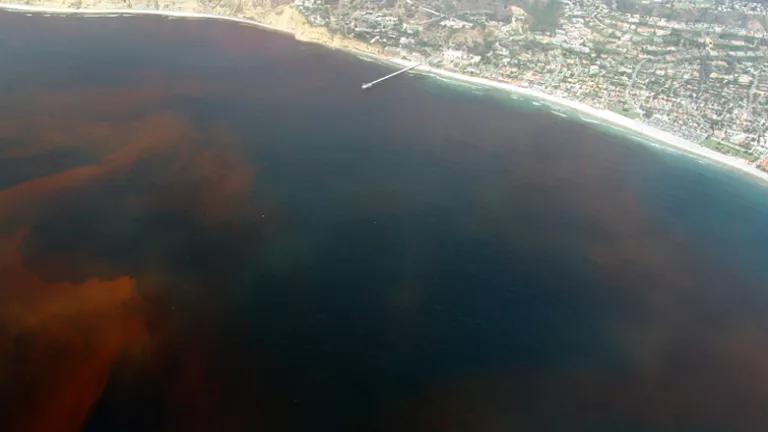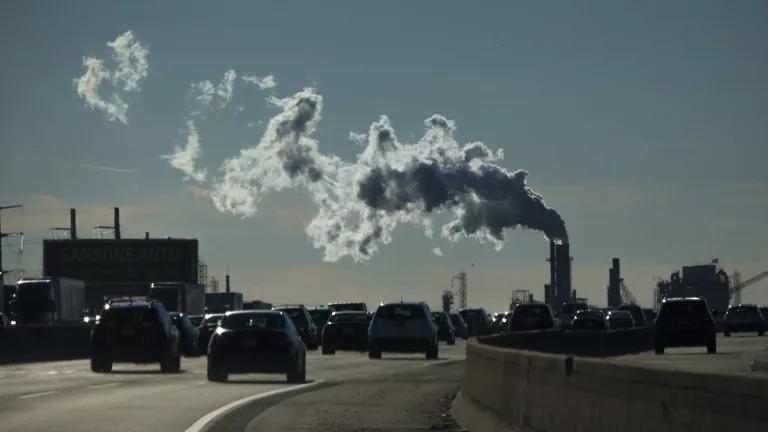Hurricane Michael Targets Florida’s Red Tide

Hurricane Michael, the strongest hurricane to ever strike Florida’s Panhandle, brought catastrophic winds, rain, and storm surge to the coastal and inland communities along Florida’s Gulf of Mexico.
The powerful storm is also expected to affect the disastrous red tide algal bloom that has been decimating Florida’s ocean life for months. But how exactly the storm will impact the red tide remains unclear.
Composite map created from western hemisphere satellite maps (NOAA/National Environmental Satellite, Data, and Information Service) and Harmful Algal Blooms Observing System (HABSOS) (NOAA/National Centers for Environmental Information)
Background
A proliferation of the microscopic organism Karenia brevis causes “red tides”. Unusual changes in nutrients, salinity, and water temperature contribute to red tide blooms, and scientists expect to see increased red tides and other harmful algal blooms as water temperatures rise with climate change.
The red tide organism produces toxins that kill fish, marine mammals, and other ocean life. The toxin may travel through the air, subjecting exposed people to respiratory effects, and accordingly, Florida emergency rooms are experiencing an increase in pneumonia, bronchitis, and asthma cases associated with the current red tide.
Hurricane Michael, Hurricane Irma, and the Red Tide
Scientists cannot predict the impact that Hurricane Michael will have on Florida’s red tide.
The winds and churning water may disrupt dense patches of the bloom and redirect the organisms further out to sea. Algal growth may be stunted by lowered water temperatures during the storm.
But the stormwaters could also carry the red tide inland, exposing more people and water life to its harmful toxins.
The torrential rains and flooding also pose a significant risk of nutrient pollution, as unfiltered water carries fertilizer, animal waste, and other nutrients from agricultural lands into the Gulf and its tributaries. These nutrients could fertilize the algae and worsen the red tide.
In fact, hurricane-related nutrient pollution has been identified as a potential driver of Florida’s continued red tide emergency. When Hurricane Irma struck the state in September 2017, a deluge of nutrient-rich water flowed from Lake Okeechobee in the agricultural center of the state through Florida’s extensive waterway systems, fueling harmful green algal blooms along its path to the Gulf of Mexico and the Atlantic Ocean. A month later, the red tide appeared, and it continues to devastate Florida’s ocean life a full year after Irma.
NRDC Fights Nutrient Pollution
Despite ample evidence that agricultural runoff contributes to the nutrient pollution driving harmful algal blooms like the Florida red tide, the Trump Administration has moved to repeal legal safeguards adopted in 2015 for small streams and wetlands which naturally filter nutrients from polluted runoff.
The Clean Water Rule recognized the critical connection between smaller bodies of water like streams and wetlands and the health of larger, navigable waters. It sought to clarify the protections afforded to these smaller waters by the Clean Water Act, including protections against agricultural runoff.
NRDC has filed two rounds of comments to the proposed repeal of the Clean Water Rule, and we will continue to fight to stop the rollback of water protections.
Join the Fight
Add your name to our Clean Water Rule Petition of Protest and tell President Trump, EPA Acting Administrator Wheeler, and Assistant Secretary James to leave the Clean Water Rule alone.


